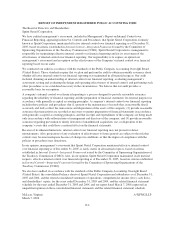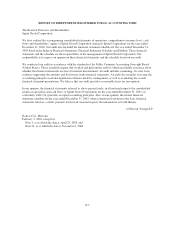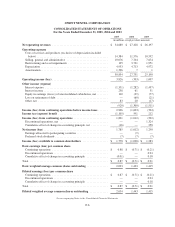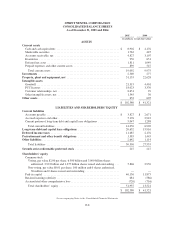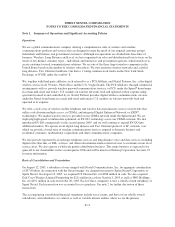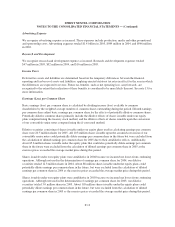Sprint - Nextel 2005 Annual Report Download - page 107
Download and view the complete annual report
Please find page 107 of the 2005 Sprint - Nextel annual report below. You can navigate through the pages in the report by either clicking on the pages listed below, or by using the keyword search tool below to find specific information within the annual report.SPRINT NEXTEL CORPORATION
NOTES TO THE CONSOLIDATED FINANCIAL STATEMENTS — (Continued)
beneficiary. All significant intercompany transactions and balances have been eliminated in consolidation. We
use the equity method to account for equity investments in unconsolidated entities in which we exercise
significant influence over operating and financial policies but do not control. We recognize all changes in our
proportionate share of the unconsolidated subsidiaries’ equity resulting from their equity transactions as
adjustments to our investment and shareholders’ equity balances. We use the cost method to account for equity
investments in all other unconsolidated entities. See note 5 for additional information.
We prepare our consolidated financial statements in conformity with accounting principles generally accepted in
the United States, which require management to make estimates and assumptions that affect the reported amounts
of assets and liabilities and disclosure of contingent assets and liabilities at the date of the financial statements
and the reported amounts of revenues and expenses during the reporting period. Due to the inherent uncertainty
involved in making those estimates, actual results could differ from those estimates.
Certain prior-period amounts have been reclassified to conform to the current period presentation. In 2005, we
determined that recategorization of certain costs from costs of services and products to selling, general and
administrative would be more consistent with current industry practices, and accordingly reclassified $1.1 billion
of expenses in each of the years ended December 31, 2004 and 2003. These costs primarily consist of certain
customer care and information technology costs for the Wireless and Long Distance segments.
Revenue Recognition
Operating revenues primarily consist of wireless service revenues, revenues generated from handset and
accessory sales and revenues from wholesale operators and PCS Affiliates, as well as long distance and local
voice, data and internet revenues.
We recognize operating revenues as services are rendered or as products are delivered to customers in
accordance with Securities and Exchange Commission, or SEC, Staff Accounting Bulletin No. 104, Revenue
Recognition, and the Emerging Issues Task Force, or EITF, Issue No. 00-21, Revenue Arrangements with
Multiple Deliverables. Revenues consist of fixed monthly recurring charges, variable usage charges, equipment
charges and miscellaneous fees such as activation fees, directory assistance, operator-assisted calling, equipment
protection, late payment charges and certain regulatory fees. We recognize revenue for access charges and other
services charged at fixed amounts ratably over the service period, net of credits and adjustments for service
discounts, billing disputes and fraud or unauthorized usage. We recognize excess usage and long distance
revenue at contractual rates per minute as minutes are used. As a result of the cutoff times of our multiple billing
cycles each month, we are required to estimate the amount of subscriber revenues earned but not billed from the
end of each billing cycle to the end of each reporting period. These estimates are based primarily on rate plans in
effect and our historical usage and billing.
Certain of our bundled products and services, primarily in Wireless, have been determined to be revenue
arrangements with multiple deliverables. Total consideration received in these arrangements is allocated and
measured using units of accounting within the arrangement based on relative fair values. We recognize revenue
from handset sales when title to the handset passes to the dealer or end user customer. We classify handset sales
as equipment revenue.
Wireless offerings include wireless phones and service contracts sold together in our company-operated stores.
The activation fee revenue associated with these direct channel sales is recognized at the time the related wireless
phone is sold and is classified as equipment sales. Wireless activation fees earned prior to the 2003 adoption of
EITF Issue No. 00-21 are being deferred and amortized over the estimated average life of the end user customer.
Certain activation fees associated with unbundled sales in our Wireless segment are deferred and amortized over
the estimated average life of the end user customer. Certain installation fees associated with our Local segment
are deferred and amortized over the estimated average life of the customer.
F-12




